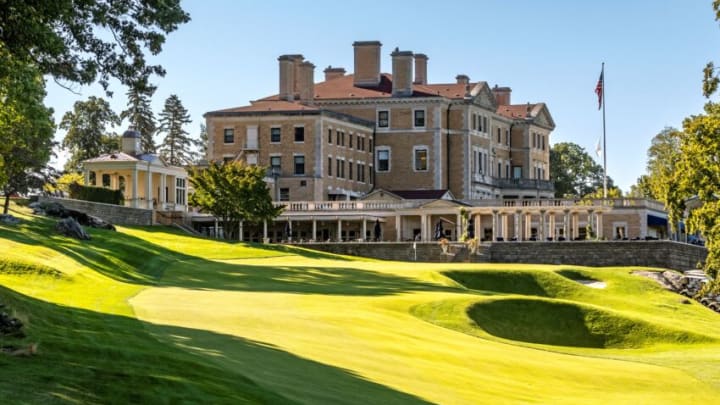While the U.S. Amateur is the most prestigious amateur golf championship conducted in the United States, the U.S. Mid-Amateur might be the purest.
You won’t find as many aspiring pros in this tournament, rather an elite group of golfers who, for many, work 9-to-5s just like the rest of us.
This is what amateur golf used to look like in the 1930s and 40s before a professional playing career provided a paycheck lucrative enough for mansions and private jets. So while the U.S. Amateur is the launching pad for many legendary pro careers, the U.S. Mid-Amateur is the launching pad for the unadulterated amateur.
The 2023 USGA U.S. Mid-Am Championship is scheduled to be held at Sleepy Hollow GC and Fenway GC from September 9-14. A lot is on the line for the 264 competitors, including a spot in the 2024 U.S. Open and likely an invite to the Masters (more on that in a bit).
Here are five important things to know about the U.S. Mid-Am as we prepare for the purest form of amateur golf.
U.S. Mid-Amatuer Fun Facts
1. It’s Free to Watch!
This was news to me so I thought it would be interesting to all the fans out there to know as well. It costs absolutely nothing to attend this event, which is saying something in this day and age where it seems every sporting event in the world is trying to squeeze every cent out of spectators.
Anyone can attend the U.S. Mid-Am and you don’t even need a ticket! Just show up to Sleepy Hollow or Fenway and watch some amazing golf with a lot on the line.
Here’s the schedule of events so you know when and where to watch the free golf.
Sept. 9 (Sleepy Hollow and Fenway): First round, stroke play
Sept. 10 (Sleepy Hollow and Fenway): Second round, stroke play
Sept. 11 (Sleepy Hollow): Round of 64, match play
Sept. 12 (Sleepy Hollow): Round of 32 and Round of 16, match play
Sept. 13 (Sleepy Hollow): Quarterfinal and semifinal rounds, match play
Sept. 14 (Sleepy Hollow): Championship match (36 holes).
2. U.S. Open and Masters Invite
Above I mentioned the winner likely getting an invite to the Masters. The likely part is there because the winner of this event needs to be classified as an amateur to secure the coveted Masters invitation.
While most of these players are amateurs, some won enough money and/or prizes early in their careers to be classified as pros. You can apply to have your professional status rolled back to amateur status. The Masters does invite the Mid-Am winner as long as they’re classified as an amateur.
Either way, the winner of this event gets an automatic invite to the U.S. Open and the next two U.S. Amatuer tournaments in addition to the next 10 U.S. Mid-Amateurs.
3. Not So Amateur Hour
There are two requirements to try and qualify for the U.S. Mid-Am: You must be 25 or older by the time the championship begins and your handicap index can not exceed 3.4. The first part is the key to keeping this a pure amateur event while the latter ensures you still have some of the best players in the world.
By the time most players are 25, they know whether or not they’re good enough to turn pro. That’s why many players involved in this tournament have regular jobs. You’ve got to make a living somehow, right? And if it’s not golf, it’s got to be something else.
As for the handicap, keeping it at 3.4 or lower ensures high competition, but also the possibility for a surprise winner. Imagine a 3-index taking down a scratch player in the final. That would be storybook.
4. Architecture Royalty
Events of this magnitude are always held at legendary courses, but the duo hosting the 42nd U.S. Mid-Am is among the best.
Sleepy Hollow was designed by C.B. Macdonald, a driver in the formation of the USGA and arguably the most important influencer in the founding of American golf architecture. Of Scottish decent, Macdonald built the first 18-hole course in America and brought the concept of the template hole to the U.S., using designs made famous in the United Kingdom in all of his famed courses in the United States.
Fenway was designed by A.W. Tillinghast, who created some of the most legendary courses in America, including many still used in Major Championship competitions today. The bunkers on his courses are some of the most famous in golf and are on full display at Fenway, where tricky greens will also play a big factor in the Mid-Am competition.
Sleepy Hollow is currently the 59th-ranked golf course in America and the 10th-best in New York by Golf Digest. Fenway has been ranked in the Top 100 courses nationally by Golf Digest previously and is currently the 29th in New York.
5. Pro Beginnings
2021-2022 PGA Tour rookie-of-the-year Cam Young grew up playing at Sleepy Hollow. His father, David Young, was the head professional at Sleepy Hollow for over 20 years and Cam’s career started at the famed Westchester course.
Before establishing himself as one of the best young players in the world, Young was the youngest player to ever win the Westchester Amateur, the Carter Cup and the Ike Championship, some of the top competitions in the competitive Met-golf area. He was also the first amateur to win the New York State Open.
David recently retired from his role at Sleepy Hollow, but his son’s rise to fame certainly played a role in the course’s notoriety increasing.
